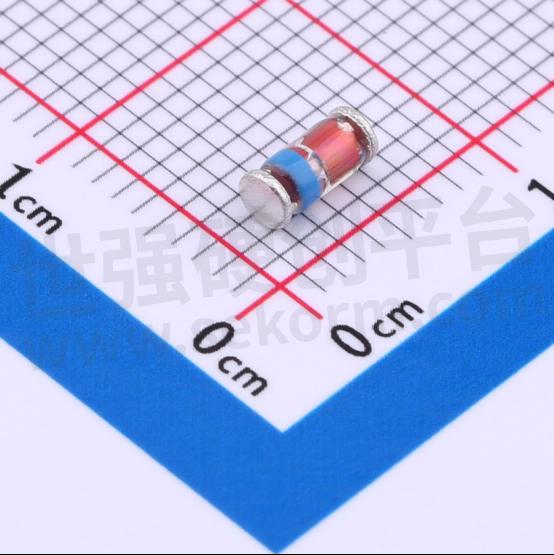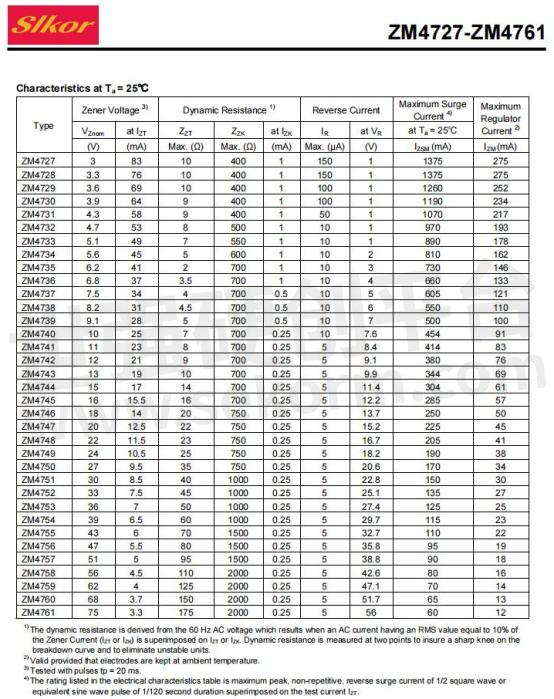In-depth Analysis and Practical Guide of Voltage Regulator Diode ZM4740A

With the rapid development of electronic technology, voltage regulator diodes are playing an increasingly important role in circuit design. Among them, ZM4740A has become the focus of attention for electronic engineers due to its unique performance characteristics. This article will provide a detailed analysis of the various parameters of the ZM4740A and offer practical application guidelines.

SLKOR Voltage Regulator Diode product photo

Slkor Voltage Regulator Diode specification
I. Performance Analysis of ZM4740A Voltage Regulator Diode
Regulation Value: The regulation value of ZM4740A
is 10V, which means it can stabilize the voltage in the circuit at
around 10V under various operating conditions, providing a stable power
supply guarantee for the circuit.
Accuracy: ZM4740A has a high accuracy of up to ±5%,
making it particularly outstanding in circuits requiring precise
voltage control. Whether in power supply circuits, amplifier circuits,
or sensor circuits, it can ensure the stability and reliability of the
circuit.
Power: The power of ZM4740A is 1W, making it
suitable for most electronic device requirements. The moderate power
output also helps extend the device's lifespan.
Reverse Current: Before reaching the breakdown
voltage, the reverse current of ZM4740A is 10μA@7.6V. This low reverse
current characteristic helps reduce circuit power consumption and
improve efficiency.
Impedance: The impedance of ZM4740A is 7Ω, enabling it to respond rapidly to current changes in the circuit and maintain stable output voltage.

Parameters of Slkor Voltage Regulator Diode
II. Application Guidelines for ZM4740A Voltage Regulator Diode
Application in Power Supply Circuits: In power
supply circuits, ZM4740A can be used as a reference voltage source to
provide a stable 10V voltage output for other circuits. By adjusting the
parameters in the circuit, precise adjustment of the output voltage can
be achieved to meet the different needs of the circuits.
Application in Amplifier Circuits: In amplifier
circuits, ZM4740A can be used to stabilize bias voltage or operating
point voltage, ensuring the stability and linearity of the amplifier.
Stable bias voltage helps improve the performance of the amplifier,
reducing distortion and noise.
Application in Sensor Circuits: Sensors typically
require a stable reference voltage to improve measurement accuracy.
ZM4740A can provide a stable 10V reference voltage for sensors, thereby
enhancing measurement accuracy and reliability.
Application in Digital Circuits: In digital circuits, ZM4740A can serve as a voltage regulator to provide a stable power supply voltage for logic gate circuits. Stable power supply voltage helps ensure the correct operation of digital circuits, reducing errors.
III. Considerations for Using ZM4740A
Power Supply Voltage Limitation: Ensure that the input voltage to ZM4740A does not exceed its maximum rated voltage and power to avoid damaging the device.
Heat Dissipation Design: In high-temperature
environments, ensure good heat dissipation for ZM4740A to prevent
overheating and affecting device performance.
Soldering and Installation: Follow relevant operation specifications during soldering and installation to avoid mechanical or thermal damage to ZM4740A.
Testing and Inspection: Prior to use, test and inspect ZM4740A to ensure its performance meets design requirements.
IV.The voltage that should be applied when the voltage regulator diode is working properly
When a voltage regulator diode is operating normally, the voltage
applied to its terminals is usually reverse voltage, and this voltage
needs to be sufficiently high to allow the voltage regulator diode to
enter the breakdown region and maintain stable reverse voltage. The
following is a detailed explanation of the voltage that should be
applied to the voltage regulator diode when it is operating normally:
Operating Voltage Range:
The operating voltage of a voltage regulator diode is usually
between 5V and 30V, but the specific operating voltage range depends on
the model and specifications of the voltage regulator diode. For
example, common voltage regulator diode models such as 1N4728A, 1N4733A,
and 1N4742A have rated voltages of 3.3V, 5.1V, and 12V, respectively.
Additionally, some voltage regulator diodes have a voltage regulation range of 3.3V to 100V, such as the 1N4728 to 1N4769 series.
Reverse Voltage:
Voltage regulator diodes are typically used as reverse-biased
components in circuits. This means that during normal operation, the
positive terminal (cathode) of the voltage regulator diode is connected
to the circuit's negative terminal (GND), while the negative terminal
(anode) is connected to the circuit's positive terminal (VCC).
To make the voltage regulator diode operate normally, sufficient reverse voltage needs to be applied across its terminals so that it enters the breakdown region and maintains stable reverse voltage.
Voltage Stabilization Characteristics:
Voltage regulator diodes have voltage stabilization characteristics,
meaning that within a certain range, regardless of the variation in
current passing through it, the voltage across its terminals can remain
essentially stable.
This stable reverse voltage is called the "stable voltage" (Uz) of
the voltage regulator diode and is an important parameter of the voltage
regulator diode.
- +1 Like
- Add to Favorites
Recommend
- Slkor Participated in the 8th Qianren Summit of Dajia Yuan
- Song Shiqiang from SLKOR Keynote Speech -How AI Empowers New Quality Productive Forces
- SLKOR‘s Optocoupler 6N136 Provides a High Level of Isolation up to 5000VRMS and Comes in a DIP-8 Package
- Comprehensive Interpretation of Slkor Voltage Regulator Diode ZM4728A
- Hong Kong Electronics Fair Helps SLKOR Internationalize
- Slkor SL15T120FL Contribute to the Fields of High-frequency Converters and Uninterruptible Power Supplies
- SLKOR 2N7002 N-channel Trench MOSFET Featuring Drain-source Voltage of 60V and Drain-source On-state Resistance of 7.5Ω
- SLKOR High-voltage MOSFET SL13N50FS with an On-resistance of 520mΩ@10V and a Continuous Drain Current of 13A
This document is provided by Sekorm Platform for VIP exclusive service. The copyright is owned by Sekorm. Without authorization, any medias, websites or individual are not allowed to reprint. When authorizing the reprint, the link of www.sekorm.com must be indicated.















































































































































































































































































































































































































































































































































































































































































































































































































































